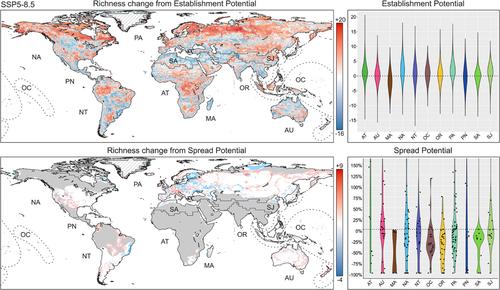当前位置:
X-MOL 学术
›
Glob. Change Biol.
›
论文详情
Our official English website, www.x-mol.net, welcomes your
feedback! (Note: you will need to create a separate account there.)
Global Distribution of Alien Mammals Under Climate Change
Global Change Biology ( IF 10.8 ) Pub Date : 2024-11-15 , DOI: 10.1111/gcb.17560 Dino Biancolini, Michela Pacifici, Mattia Falaschi, Céline Bellard, Tim M. Blackburn, Gentile Francesco Ficetola, Carlo Rondinini
Global Change Biology ( IF 10.8 ) Pub Date : 2024-11-15 , DOI: 10.1111/gcb.17560 Dino Biancolini, Michela Pacifici, Mattia Falaschi, Céline Bellard, Tim M. Blackburn, Gentile Francesco Ficetola, Carlo Rondinini

|
The recent thematic Assessment Report on Invasive Alien Species and their Control of the Intergovernmental Science‐Policy Platform on Biodiversity and Ecosystem Services reaffirmed biological invasions as a major threat to biodiversity. Anticipating biological invasions is crucial for avoiding their ecological and socio‐economic impacts, particularly as climate change may provide new opportunities for the establishment and spread of alien species. However, no studies have combined assessments of suitability and dispersal to evaluate the invasion by key taxonomic groups, such as mammals. Using species distribution models, we estimated the potential effect of climate change on the future distributions of 205 alien mammal species by the year 2050 under three different climatic scenarios. We used species dispersal ability to differentiate between suitable areas that may be susceptible to natural dispersal from alien ranges (Spread Potential, SP) and those that may be vulnerable to alien establishment through human‐assisted dispersal (Establishment Potential, EP) across 11 zoogeographic realms. Establishment Potential was generally boosted by climate change, showing a clear poleward shift across scenarios, whereas SP was negatively affected by climate change and limited by alien species insularity. These trends were consistent across all realms. Insular ecosystems, while being vulnerable to invasion, may act as geographical traps for alien mammals that lose climatic suitability. In addition, our analysis identified the alien species that are expected to spread or decline the most in each realm, primarily generalists with high invasive potential, as likely foci of future management efforts. In some areas, the possible reduction in suitability for alien mammals could offer opportunities for ecosystem restoration, particularly on islands. In others, increased suitability calls for adequate actions to prevent their arrival and spread. Our findings are potentially valuable in informing synergistic actions addressing both climate change and biological invasion together to safeguard native biodiversity worldwide.
中文翻译:

气候变化下外来哺乳动物的全球分布
生物多样性和生态系统服务政府间科学政策平台最近发布的关于外来入侵物种及其控制的专题评估报告重申,生物入侵是对生物多样性的主要威胁。预测生物入侵对于避免其生态和社会经济影响至关重要,特别是因为气候变化可能为外来物种的建立和传播提供新的机会。然而,没有研究将适宜性和扩散评估结合起来,以评估关键分类群(如哺乳动物)的入侵。使用物种分布模型,我们估计了在三种不同气候情景下,到 2050 年气候变化对 205 种外来哺乳动物物种未来分布的潜在影响。我们使用物种扩散能力来区分可能容易受到外来范围自然扩散的合适区域(传播潜力,SP)和那些可能容易通过人类辅助传播(建立潜力,EP)在 11 个动物地理领域建立的合适区域。建立潜力通常受到气候变化的提振,在不同情景中表现出明显的极向转变,而 SP 则受到气候变化的负面影响并受到外来物种孤立性的限制。这些趋势在所有领域都是一致的。岛屿生态系统虽然容易受到入侵,但可能会成为失去气候适应性的外来哺乳动物的地理陷阱。此外,我们的分析确定了预计在每个领域传播或减少最多的外来物种,主要是具有高入侵潜力的通才物种,这可能是未来管理工作的重点。 在一些地区,对外来哺乳动物的适宜性可能降低,这可能为生态系统恢复提供机会,特别是在岛屿上。在另一些国家,适宜性的提高需要采取适当的措施来防止其到达和传播。我们的研究结果在为共同应对气候变化和生物入侵的协同行动提供信息以保护全球本土生物多样性方面具有潜在价值。
更新日期:2024-11-15
中文翻译:

气候变化下外来哺乳动物的全球分布
生物多样性和生态系统服务政府间科学政策平台最近发布的关于外来入侵物种及其控制的专题评估报告重申,生物入侵是对生物多样性的主要威胁。预测生物入侵对于避免其生态和社会经济影响至关重要,特别是因为气候变化可能为外来物种的建立和传播提供新的机会。然而,没有研究将适宜性和扩散评估结合起来,以评估关键分类群(如哺乳动物)的入侵。使用物种分布模型,我们估计了在三种不同气候情景下,到 2050 年气候变化对 205 种外来哺乳动物物种未来分布的潜在影响。我们使用物种扩散能力来区分可能容易受到外来范围自然扩散的合适区域(传播潜力,SP)和那些可能容易通过人类辅助传播(建立潜力,EP)在 11 个动物地理领域建立的合适区域。建立潜力通常受到气候变化的提振,在不同情景中表现出明显的极向转变,而 SP 则受到气候变化的负面影响并受到外来物种孤立性的限制。这些趋势在所有领域都是一致的。岛屿生态系统虽然容易受到入侵,但可能会成为失去气候适应性的外来哺乳动物的地理陷阱。此外,我们的分析确定了预计在每个领域传播或减少最多的外来物种,主要是具有高入侵潜力的通才物种,这可能是未来管理工作的重点。 在一些地区,对外来哺乳动物的适宜性可能降低,这可能为生态系统恢复提供机会,特别是在岛屿上。在另一些国家,适宜性的提高需要采取适当的措施来防止其到达和传播。我们的研究结果在为共同应对气候变化和生物入侵的协同行动提供信息以保护全球本土生物多样性方面具有潜在价值。


















































 京公网安备 11010802027423号
京公网安备 11010802027423号